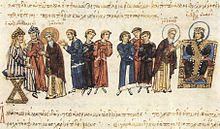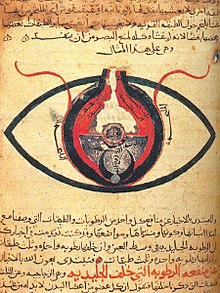Heyday of Islam

In popular scientific literature, the civilization developed under the Abbasids (750 AD - 1258 AD) in areas under Islamic control is referred to as the heyday of Islam (also known as the Golden Age of Islam ) . A center for art, culture, science and research emerged in just a few decades in the city of Baghdad, which was founded in 762 . It inherited the Persian metropolis of Seleukia-Ctesiphon, a few kilometers away, which was conquered by the Arabs in 637 .
Also a center of knowledge and literature, this region has Khorasan in Central Asia . It later formed the core of the Iranian renaissance .
Al-Andalus , ruled by the Moors , in particular the emirate of Córdoba / Caliphate of Córdoba and the later emirate of Granada in the south of the Iberian Peninsula , flourished in culture and science in the Middle Ages.
The leading position in the sciences can still be recognized today by the Arabic prefix al- in basic technical terms such as algebra , alchemy , alcohol and alkalis . The most famous scientists were active in the following areas:
medicine

- Hunayn ibn Ishaq , Latinized Johannitius (809-874), Christian-Arabic physician, historian, known for translations of Aristotle , Hippocrates and Galen as well as for important books on the introduction to medicine and ophthalmology.
- Abu Bakr Mohammad Ibn Zakariya al-Razi , Latinized Rhazes (865–925), Persian polymath, was one of the first to recognize the difference between smallpox and measles and already tried plaster casts to heal broken bones. His medical work remained unchallenged until the 17th century.
- Ibn Sina , Latinized Avicenna (980-1037), the most famous medicin of Islam and Persian. He translated the writings of Aristotle , Hippocrates and Galen . He also wrote the canon of medicine , which was the most important book on medicine until the 17th century.
- Ibn an-Nafis (died around 1288) discovered the small blood circulation through theoretical considerations .
mathematics

- By using the Indian numerals , the Persian mathematician al-Chwarizmi (780–846) triggered a revolution in calculation methods. Furthermore, the word algorithm can be traced back to him and in his work Hisab al-dschabr wa-l-muqabala he explains (as can be seen from the title) the algebra branch, which was renewed for mathematics at the time .
- Significant discoveries in the field of trigonometry ( sines , tangent rule) made the Persian scholar Abu al-Wafa (940-998). He also translated Ptomemaios' main work Almagest into Arabic.
- Al-Biruni (973-1048) was one of the great universal scholars of the Middle Ages.
- The Persian mathematician, astronomer, philosopher and poet Omar Chayyām (1048–1131) invented the triangle of binomial coefficients and described the solution of cubic equations .
astronomy
- The most important astronomer was Muhammad Ibn Jubair al-Battani , Latinized Albategnius or Albatanius (858-929). He passed on the astronomy of Ptolemy and determined, among other things, the skew of the ecliptic and the equinox .
- Abd ar-Rahman as-Sufi (903–986) wrote a book about the well-known constellations with star names and brightnesses.
- Ibn Yunus (950-1009), the court astronomer at the Caliph's court, set up the "Hakimitic planet tables".
- Abu Ali al-Hasan ibn al-Haitham , Latinized Alhazen (965-1040), astronomer and physicist, contributed works on optics and planetary motions that were decisive up to Kepler . He recognized the fundamentals of the visual process, the importance of the curvature of the lens and described the principle of the " camera obscura ".
- Ali ibn Abi r-Ridschal , Latinized Abenragel (around 1040), wrote the most extensive textbook of the Middle Ages on astrology. Alfonso X had it translated into Castilian .
- The experimental physicist of the Middle Ages was Abu l-Fath Abd ar-Rahman ( al-Chazini ) in the 12th century. Among other things, he constructed water clocks, quadrants, compasses and created the "Sandjarian tables" for determining planets.
- Muhammad Taragay ( Ulugh Beg ) (1394–1449), as ruler in Samarkand , created the largest observatory of the time. His handbook on astronomy was only surpassed in accuracy by Brahe .
Star names like Aldebaran , Algol , Altair , Rigel and others as well as the designation Zenit and Nadir come from Arabic.
chemistry
- Dschābir ibn Hayyān , Latinized Geber , the Arab scholar who probably worked in the second half of the 8th century, carried out physical-chemical experiments and compiled a large collection of alchemical knowledge in his writings on natural philosophy (Geber writings) .
geography
- Among the most important Islamic geographers of the Middle Ages were Muhammad asch-Sharif al-Idrisi , who was in the service of the Norman King Roger II of Sicily , latinized Dreses (1099–1166), who made maps of the continents known at the time, and of Cordoba living Abū ʿUbaid al-Bakrī (1014-1094).
literature
- In the literary field, one first thinks of the well-known “ Tales from a Thousand and One Nights ” ( alf laila wa-laila ), which originated in various regions of the Orient as early as the 8th century and which became popular in German-speaking countries thanks to the translation by Gustav Weil are.
- The work of Abū l-Qāsem-e Ferdousī , Latinized Firdausi , (940–1020), Shāhnāme or “Book of Kings”, originated around 1010, authoritative for Persian literature . Stories in which original religious motifs and heroic sagas were recorded in 50,000 verses.
- Hafis , too , (around 1320 – around 1390) with his work “Diwan” and his love poems still enrich the culture of our time to this day.
- The poet al-Ma'arri (973-1057) dealt with paradise and hell in his work " Epistles on forgiveness" ( risalat al-ghufran ).
- The poet Jalal ad-Din ar-Rumi (1207–1273) with his 25,700 lines of verse, Mathnawi .
- The poet and mystic Dschami (1414–1492) with his masterpiece Lailā and Majnūn .
philosophy

- Ibn Ruschd , latinized Averroes , is one of the greatest universal scholars of Islam alongside al-Biruni . He wrote a medical encyclopedia and commented on almost every work by Aristotle. In the Christian scholasticism of the Middle Ages, on which he exerted great influence, he was therefore simply referred to as "the commentator", just as Aristotle was only called "the philosopher".
- al-Kindī , Latinized Alkindus , had numerous works by Aristotle and other Greek philosophers translated by collaborators, some of whom were of Greek-Christian origin. He is considered the first great philosopher of Islam and was one of the founders of a mathematical way of thinking in philosophy → logic .
music
literature
- Thomas Bauer : Why there was no Islamic Middle Ages. The legacy of antiquity and the Orient. CH Beck, Munich 2018, ISBN 978-3-406-72730-6 .
- Gudrun Krämer : History of Islam . CH Beck, Munich 2005, ISBN 978-3-406-53516-1 , pp. 69-102
- Maurice Lombard: the heyday of Islam. An economic and cultural history 8.-11. Century . Fischer, Frankfurt am Main 1992, ISBN 3-596-10773-3
- Tamara Sonn : Islam: A Brief History . Wiley, Chichester 2010, ISBN 978-1-4051-8094-8 , pp. 39-79 ( excerpt (Google) )
Individual evidence
- ↑ Maurice Lombard: The heyday of Islam. An economic and cultural history 8.-11. Century. Fischer Taschenbuch Published by Frankfurt am Main 1992.
- ↑ Monika Gronke : History of Iran: From Islamization to the Present . CH Beck 2003, ISBN 3-406-48021-7 , pp. 30-31
- ↑ Friedrich Klütsch : From the heyday of Islam. Author and director Friedrich Klütsch on Andalusian finds , ZDF online, May 17, 2009, accessed on November 5, 2013
- ^ Works by Hali filius Abenragel (Albohazen) in the complete catalog of the Wiegendrucke